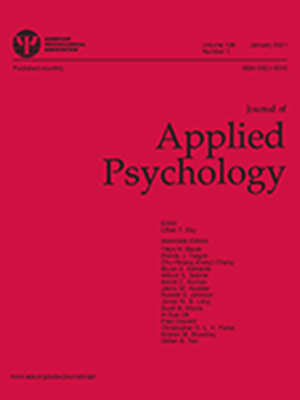From cues to categorizations: An integrative framework for leader (re-)categorization over time.
IF 6.1
1区 心理学
Q1 MANAGEMENT
引用次数: 0
Abstract
Who is perceived as a leader? Traditional theories of leader categorization have primarily emphasized observable behaviors as the key basis for making this judgment. However, a growing body of research shows that perceivers rely on a broader set of cues-beyond behavior alone-that differentially shape leadership attributions. To integrate these perspectives, we present a comprehensive review of how multiple-and sometimes competing-cues are perceived, interpreted, and activated as traits in the leader categorization process. To explain when and why certain cues are attended to while others are overlooked, we draw on a previously overlooked body of research on cue properties, illustrating how characteristics such as cue availability, discriminability, salience, and accessibility influence leadership perceptions. We further demonstrate how cue properties can shift over time by distinguishing cues in terms of their dynamism, with important implications for leader re-categorization. We conclude by offering directions for future research, practical recommendations for individuals seeking to be perceived as leaders, and suggestions for improving leader selection. Our review suggests that recognizing differences among cues and unpacking the process of cue integration is critical for the advancement of leader categorization research. (PsycInfo Database Record (c) 2025 APA, all rights reserved).从线索到分类:一个随时间变化的领导(再)分类的综合框架。
谁被视为领导者?传统的领导者分类理论主要强调可观察到的行为作为做出这种判断的关键依据。然而,越来越多的研究表明,感知者依赖于更广泛的线索——除了行为本身——来不同地塑造领导力归因。为了整合这些观点,我们全面回顾了在领导者分类过程中,多重线索(有时是竞争线索)是如何被感知、解释和激活为特质的。为了解释何时以及为什么某些线索被注意而其他线索被忽视,我们借鉴了先前被忽视的线索属性研究,说明线索的可用性、可辨别性、显著性和可及性等特征如何影响领导认知。我们进一步论证了线索属性如何随着时间的推移而变化,通过区分线索的动态,这对领导者重新分类具有重要意义。最后,我们为未来的研究提供了方向,为寻求被视为领导者的个人提供了实用建议,并提出了改进领导者选择的建议。我们的研究表明,识别线索之间的差异并揭示线索整合的过程对于推进领导分类研究至关重要。(PsycInfo Database Record (c) 2025 APA,版权所有)。
本文章由计算机程序翻译,如有差异,请以英文原文为准。
求助全文
约1分钟内获得全文
求助全文
来源期刊

Journal of Applied Psychology
Multiple-
CiteScore
17.60
自引率
6.10%
发文量
175
期刊介绍:
The Journal of Applied Psychology® focuses on publishing original investigations that contribute new knowledge and understanding to fields of applied psychology (excluding clinical and applied experimental or human factors, which are better suited for other APA journals). The journal primarily considers empirical and theoretical investigations that enhance understanding of cognitive, motivational, affective, and behavioral psychological phenomena in work and organizational settings. These phenomena can occur at individual, group, organizational, or cultural levels, and in various work settings such as business, education, training, health, service, government, or military institutions. The journal welcomes submissions from both public and private sector organizations, for-profit or nonprofit. It publishes several types of articles, including:
1.Rigorously conducted empirical investigations that expand conceptual understanding (original investigations or meta-analyses).
2.Theory development articles and integrative conceptual reviews that synthesize literature and generate new theories on psychological phenomena to stimulate novel research.
3.Rigorously conducted qualitative research on phenomena that are challenging to capture with quantitative methods or require inductive theory building.
 求助内容:
求助内容: 应助结果提醒方式:
应助结果提醒方式:


